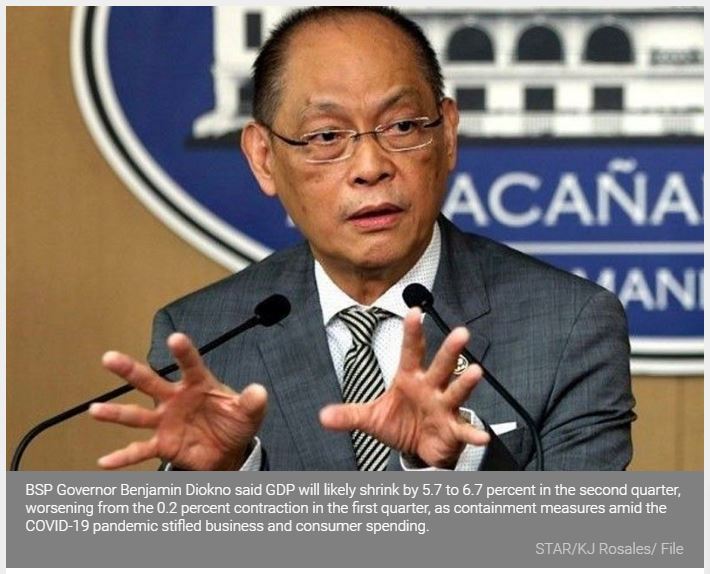‘Philippines sinks into recession’
GDP slump worsens in Q2 — BSP
MANILA, Philippines — A deeper economic slump looms in the second quarter, with gross domestic product (GDP) contracting by as much as 6.7 percent due to the full impact of the tight lockdown aimed at preventing the spread of the coronavirus disease, the Bangko Sentral ng Pilipnas said.
BSP Governor Benjamin Diokno said GDP will likely shrink by 5.7 to 6.7 percent in the second quarter, worsening from the 0.2 percent contraction in the first quarter, as containment measures amid the COVID-19 pandemic stifled business and consumer spending.
“The negative impact of the COVID-19 crisis is harsher than what was originally thought,” Diokno told reporters via Viber.
Two consecutive quarters of GDP contraction will put the economy in recession. The economy ground to a halt after Malacañang placed the entire Luzon under an enhanced community quarantine in mid-March but was gradually relaxed to a general community quarantine last June 1.
Economic managers through the Development Budget Coordination Committee (DBCC) expect GDP to contract by two to 3.4 percent this year from a growth of six percent last year. This would end more than two decades of growth as the GDP last contracted by 0.5 percent in 1998 during the height of the Asian financial crisis.
On Friday, S&P Global Ratings announced a deeper GDP contraction of three percent instead of 0.2 percent this year after the Philippines implemented one of the world’s longest tight lockdowns to combat COVID-19.
“The S&P forecast for the Philippines falls within the government’s revised projection that the economy will contract between two and 3.4 percent,” Diokno said.
He said the projected GDP of the Philippines is right in the middle of the growth forecasts for the Association of Southeast Asian Nations (ASEAN) with Vietnam and Indonesia growing by 1.2 percent and 0.7 percent, respectively, and the economies of Singapore and Thailand contracting by five percent and 5.1 percent, respectively.
The BSP chief added the deeper contraction seen by S&P should be seen in a positive light as it is better than the revised forecasts of multila-teral lenders.
The International Monetary Fund (IMF) downgraded Philippine GDP to a 3.6 percent contraction instead of growing by 0.6 percent this year as it sees the global economy shrinking by 4.9 percent instead of three percent due to the pandemic.
On the other hand, the Asian Development Bank (ADB) is now looking at a contraction of 3.8 percent instead of a two percent expansion as growth across Asia Pacific is seen falling to a 59-year low.
For 2021, Diokno said S&P expects a strong recovery for the Philippines, with GDP growing by 9.4 percent, better than the eight to nine percent growth penned by the DBCC.
“The other good news is that the rating agency sees a strong rebound for the Philippine economy next year, as it forecasts that the economy will bounce back by 9.4 percent as economic activities resume,” Diokno added.
S&P has affirmed the country’s BBB+ credit rating – a notch below A grade -and stable outlook last May, while Moody’s Investors Service also retained the country’s Baa2 rating – two notches above minimum investment grade – and stable outlook.
On the other hand, Fitch Ratings lowered the country’s outlook to stable from positive but retained its BBB rating in early May due to the expected economic fallout from the COVID-19 pandemic.
However, the Philippines finally attained the much coveted A grade after receiving an upgrade from Japan Credit Rating Agency to A- from BBB+, reflecting the resilience of the Philippines amid the health crisis.
Source: https://www.philstar.com/business/2020/06/28/2024154/philippines-sinks-recession


 English
English




